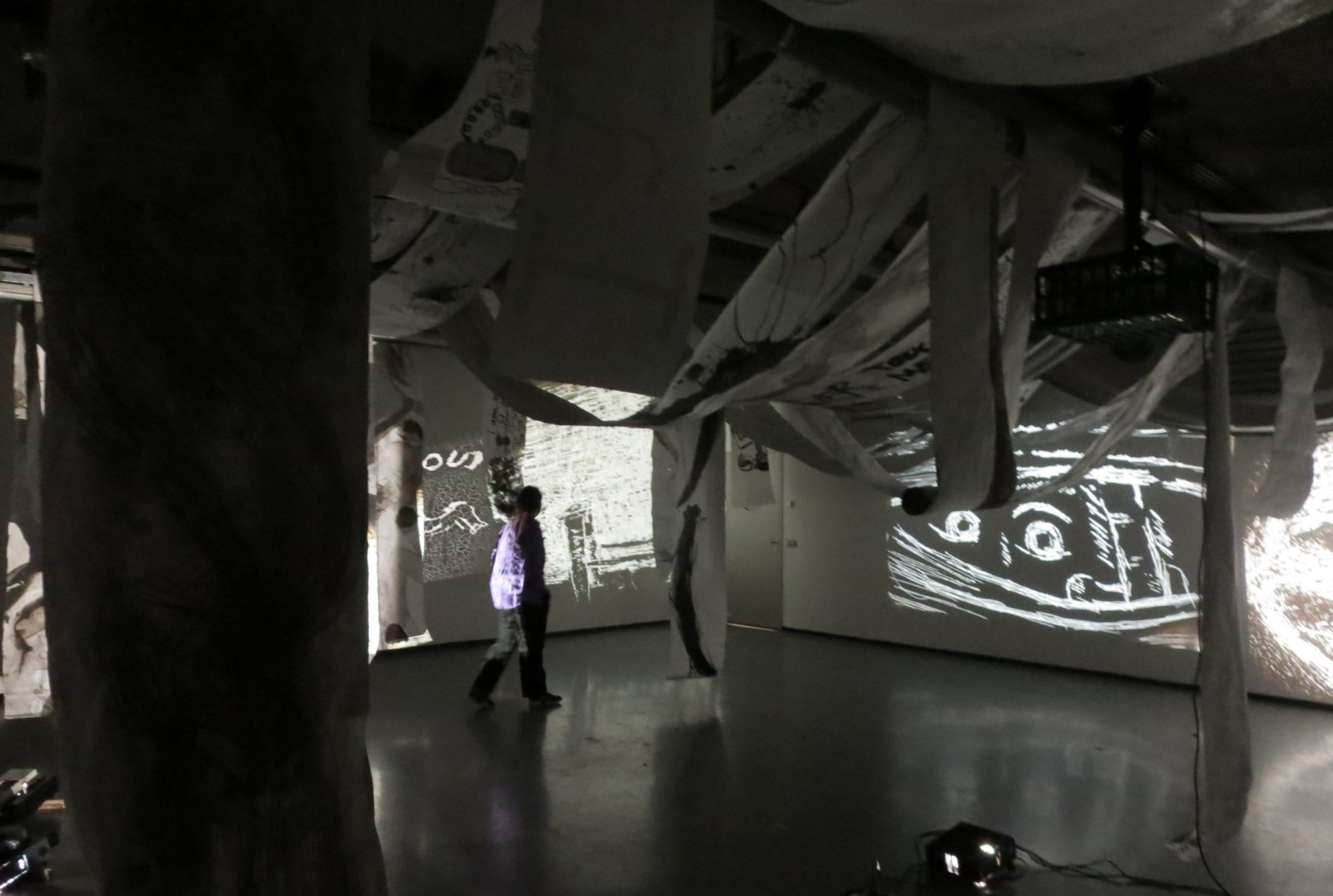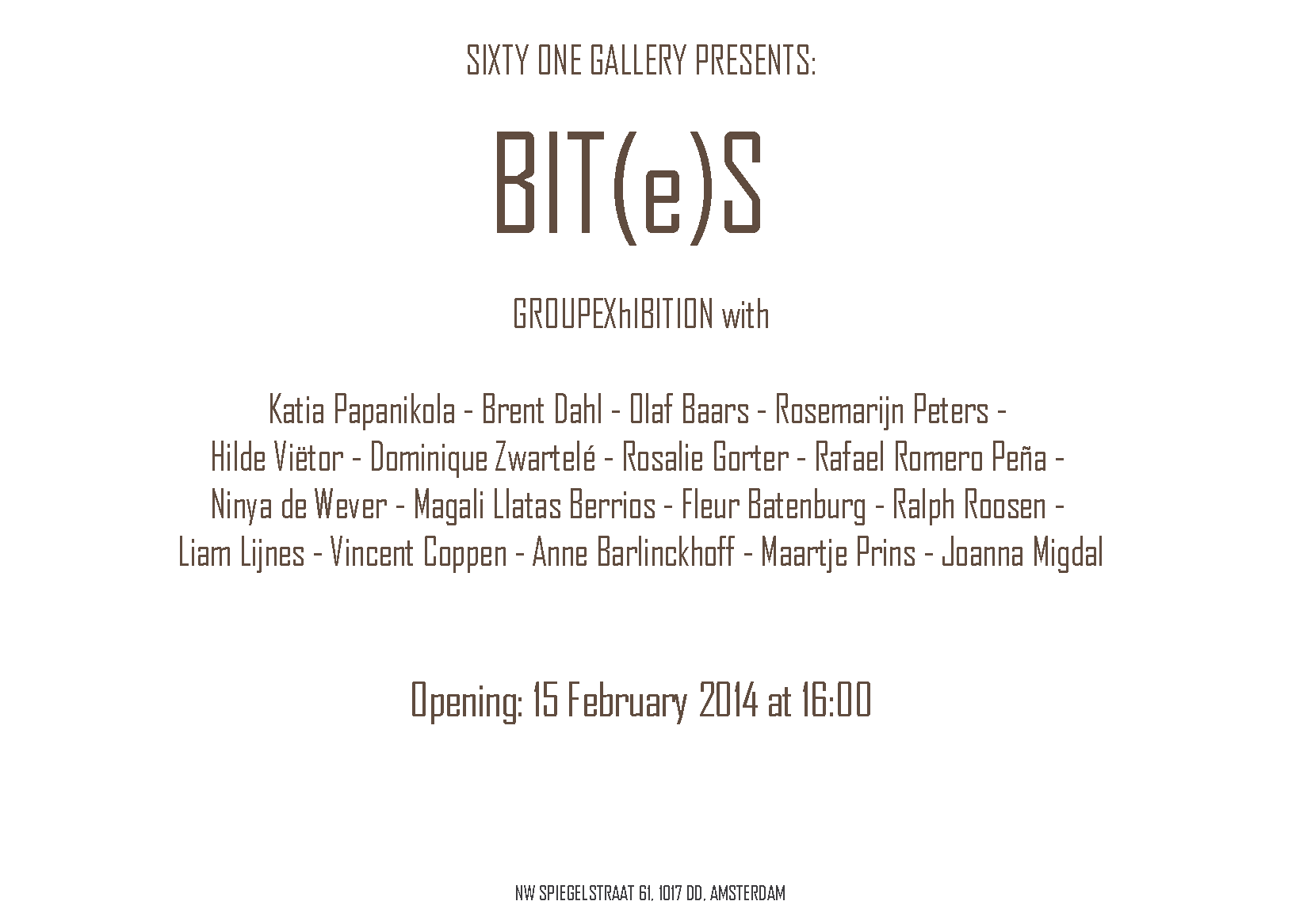Interaction Design Unstable Media
CATALOGUE OF EFFECTS
In most of the stories and novels by the Japanese author Kobo Abe, writer of ‘The Woman in the Dunes’, famously adapted for
cinema by Hiroshi Teshigahara, the main characters do not have a name. They are more or less synonymous with a profession, or they are just beings, without any specific qualities. They could have been anyone. Like in the story ‘The Box Man’, in which the nameless protagonist gives up his identity and decides to live in a large cardboard box he wears over his head. As he wanders through the streets of Tokyo, he describes the world outside as he sees or imagines it, in a madly rush on the inside walls of his box. In a style reminiscent of Kafka, Abe conveys the story of the man by following what he writes down as life comes to him, as if in a dream, via the mediation of the box. The box grants him a life and an identity : he becomes the box man, and he becomes the interpreter of the effects that the box has on him, as it changes his relationship with the world outside of the box. The box becomes the interface of his choice to live his life, as he becomes the ardent scribbler of the effects that this choice exert upon him.
What is the difference between a box we put over our head and that we use as a canvas for our writing or a little black box we carry around all time and with which we explore the world, by tapping on it, talking to it, scribbling on it? In both cases we are dealing with an interfaced reality, and a deep acknowledgement that life is fundamentally ‘out of the box’. Yet, we are trapped, by our free choice to live inside that box or via that box.
At IDUM we are not interested in the box as object per se, but more in the effects it has on you when you put it over your head. Subjectivity is not something that resides cosy and statically behind your artistic eyes, but is actively produced by a world around you and by the way you react upon that world.
Our graduation candidates of this year each have found a box to put over their heads in order to explore the effects they exert upon them and what those effects tell us about boxing and living inside a box, and what can be perceived of a life outside of that box. Ans has put the box of her own memory over her head to explore what memory does to the live of a person that once was part of her life, but resides only as an effect of the past. Carlos has used the box of Thinspo, he found on the internet over his head, to try to come close to what these tiny little girls online experience in their radical disappearance act. Jelmer has chosen to use language as a box, or container of subjectivities in order to investigate how language becomes a infinitesimal small film or tissue that mediates intensities, but that can evaporate into even thinner air.
In order to be able to ‘live and think outside of the box’ you have to create a catalogue of effects of what it is to live in a box.
Willem van Weelden
Thesis Lecturer DOGtime IDUM 5
WHAT BOX?
In order to prepare the candidates for their graduation I arranged for individual sessions of 45 minutes about every other week. I believe in individual coaching, which is of course a luxury. Unlike Art, which is a necessity.
If you think instead that art is a commodity, we are likely to have a semantic misunderstanding.
When talking about art, you might think I mean the stuff you see in galleries, the stuff that gets commissioned and the stuff that involves matter & technology. We can actually do without all of that. (However, it would make life financially unbearable for me.) But we can’t do without a poetic dimension of what culture presents to us as ‘real’ or ‘truth’.
So when I mention art I mean activities and/or artefacts which are articulating, exploring and creating this poetic dimension of ‘the real’. This art defies the notion of art as a commodity. It even defies the notion of art as contemporary art, but we should not completely rule out the possibility that contemporary art touches upon a poetic quality that makes life worthwhile, as that would be truly cynical.
The ‘why’ we want to travel from A to B can never be explained, but it might be possible to share the experience of traveling? In a world without poetry we just move from A to B, we start and graduate, maybe, we learn to think out of the box. But in the world of these DOGTIME graduates, we learn to shape and share the experience of the journey, defying the notion of a box.
Geert Mul 2014
Lecturer DOGtime IDUM 5
PS:
In order to drill my students to become great artists, I had them standing up and when I shouted questions, I made them shout back answers to me over and over again until they finally stopped thinking and just listened.
This is the drill:
Why Art?
I’m creative!
What is the core of the creative practice?
To create!
What does the creative strive for?
Leaving traces!
What are its means?
Disagreement!
What is untrue?
Contradictions!
What is the core of artistic practice?
Practice!
What does art strive for?
Mind over matter!
What do you strive for?
Consciousness!
What is artistic knowledge?
Speculative!
What is art’s biggest enemy?
Artistic consensus!
What is a medium?
Embodied consensus!
What is meaning?
Context!
What is context?
Meaning!
What does art consists of?
Language!
What is knowledge?
Poetry!
What does Poetry learn us?
The impossibility of notation!
Interaction Design Unstable Media
CATALOGUE OF EFFECTS
In most of the stories and novels by the Japanese author Kobo Abe, writer of ‘The Woman in the Dunes’, famously adapted for
cinema by Hiroshi Teshigahara, the main characters do not have a name. They are more or less synonymous with a profession, or they are just beings, without any specific qualities. They could have been anyone. Like in the story ‘The Box Man’, in which the nameless protagonist gives up his identity and decides to live in a large cardboard box he wears over his head. As he wanders through the streets of Tokyo, he describes the world outside as he sees or imagines it, in a madly rush on the inside walls of his box. In a style reminiscent of Kafka, Abe conveys the story of the man by following what he writes down as life comes to him, as if in a dream, via the mediation of the box. The box grants him a life and an identity : he becomes the box man, and he becomes the interpreter of the effects that the box has on him, as it changes his relationship with the world outside of the box. The box becomes the interface of his choice to live his life, as he becomes the ardent scribbler of the effects that this choice exert upon him.
What is the difference between a box we put over our head and that we use as a canvas for our writing or a little black box we carry around all time and with which we explore the world, by tapping on it, talking to it, scribbling on it? In both cases we are dealing with an interfaced reality, and a deep acknowledgement that life is fundamentally ‘out of the box’. Yet, we are trapped, by our free choice to live inside that box or via that box.
At IDUM we are not interested in the box as object per se, but more in the effects it has on you when you put it over your head. Subjectivity is not something that resides cosy and statically behind your artistic eyes, but is actively produced by a world around you and by the way you react upon that world.
Our graduation candidates of this year each have found a box to put over their heads in order to explore the effects they exert upon them and what those effects tell us about boxing and living inside a box, and what can be perceived of a life outside of that box. Ans has put the box of her own memory over her head to explore what memory does to the live of a person that once was part of her life, but resides only as an effect of the past. Carlos has used the box of Thinspo, he found on the internet over his head, to try to come close to what these tiny little girls online experience in their radical disappearance act. Jelmer has chosen to use language as a box, or container of subjectivities in order to investigate how language becomes a infinitesimal small film or tissue that mediates intensities, but that can evaporate into even thinner air.
In order to be able to ‘live and think outside of the box’ you have to create a catalogue of effects of what it is to live in a box.
Willem van Weelden
Thesis Lecturer DOGtime IDUM 5
WHAT BOX?
In order to prepare the candidates for their graduation I arranged for individual sessions of 45 minutes about every other week. I believe in individual coaching, which is of course a luxury. Unlike Art, which is a necessity.
If you think instead that art is a commodity, we are likely to have a semantic misunderstanding.
When talking about art, you might think I mean the stuff you see in galleries, the stuff that gets commissioned and the stuff that involves matter & technology. We can actually do without all of that. (However, it would make life financially unbearable for me.) But we can’t do without a poetic dimension of what culture presents to us as ‘real’ or ‘truth’.
So when I mention art I mean activities and/or artefacts which are articulating, exploring and creating this poetic dimension of ‘the real’. This art defies the notion of art as a commodity. It even defies the notion of art as contemporary art, but we should not completely rule out the possibility that contemporary art touches upon a poetic quality that makes life worthwhile, as that would be truly cynical.
The ‘why’ we want to travel from A to B can never be explained, but it might be possible to share the experience of traveling? In a world without poetry we just move from A to B, we start and graduate, maybe, we learn to think out of the box. But in the world of these DOGTIME graduates, we learn to shape and share the experience of the journey, defying the notion of a box.
Geert Mul 2014
Lecturer DOGtime IDUM 5
PS:
In order to drill my students to become great artists, I had them standing up and when I shouted questions, I made them shout back answers to me over and over again until they finally stopped thinking and just listened.
This is the drill:
Why Art?
I’m creative!
What is the core of the creative practice?
To create!
What does the creative strive for?
Leaving traces!
What are its means?
Disagreement!
What is untrue?
Contradictions!
What is the core of artistic practice?
Practice!
What does art strive for?
Mind over matter!
What do you strive for?
Consciousness!
What is artistic knowledge?
Speculative!
What is art’s biggest enemy?
Artistic consensus!
What is a medium?
Embodied consensus!
What is meaning?
Context!
What is context?
Meaning!
What does art consists of?
Language!
What is knowledge?
Poetry!
What does Poetry learn us?
The impossibility of notation!

